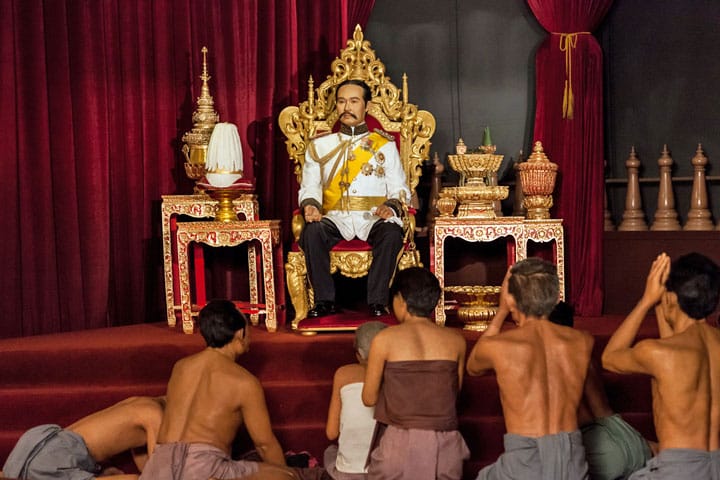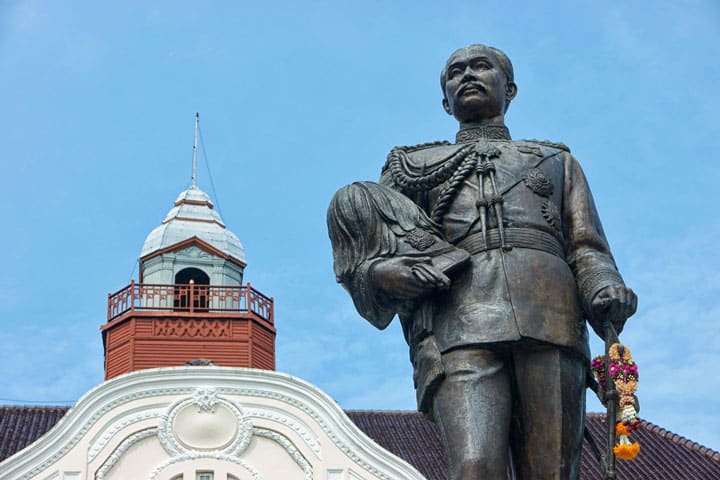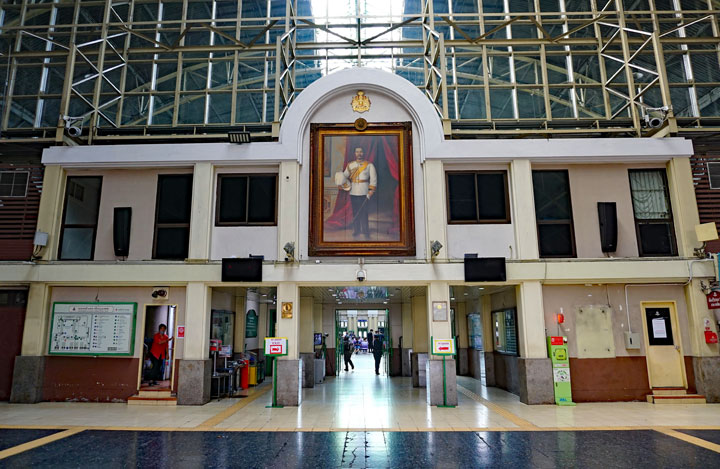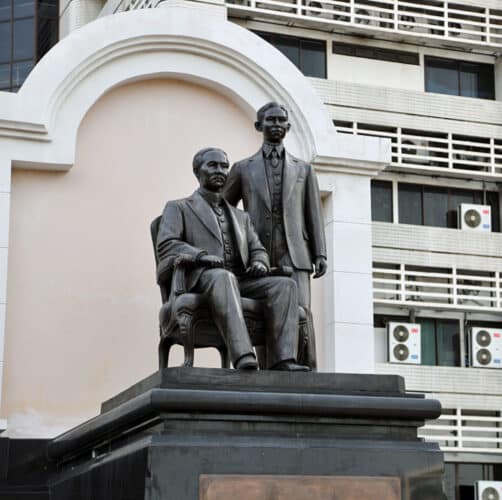
In every Thai house hangs a portrait of King Chulalongkorn, Rama V. Usually dressed in a neat Western costume, he proudly looks out into the world. And with good reason.
He is referred to as King Chulalongkorn the Great for his many contributions to the reform and modernization of Thailand and for his diplomatic gifts which saved Thailand from colonization by the Western powers.
After a short sketch of his life, we follow him on his many travels, first in Asia and later to Europe. 'A Quest for Siwilai (civilization)', a 'Quest for Civilization' his contemporaries called it.
This is followed by two news reports about his visit to the Netherlands (September 1897) from Dutch newspapers.
A short sketch of his life
Chulalongkorn was the son of King Mongkut and was born on September 20, 1853. His father, himself infected with the Western scientific virus, gave him a solid education, often by European teachers such as Anna Leonowens. He is said to have spoken fluent English and French.
In 1867, father and son traveled south to observe a solar eclipse. Both were stricken with malaria, Mongkut did not survive and so Chulalongkorn became king at the age of fifteen (1868). After a regency of five years and some time as a monk, he was finally crowned in 1873.
Even then, after a number of trips to Asia, he was convinced that Thailand needed to reform. Resistance from powerful courtiers made this process go at a snail's pace at first. But from 1880 Chulalongkorn seized all power and absolute kingship was born.
His reforms were many. He set up a bureaucracy on the Western, or rather, on the colonial model, which for the first time extended its power over the whole of Thailand. He abolished slavery and serfdom. He established an efficient military and police force that aided in internal colonization to the north and northeast. He promoted education and gradually introduced the practice of Bangkok Buddhism to the entire country.
He succeeded, with some territorial concessions, in thwarting the colonial powers, France and England. Bangkok was one of the first cities in the world with electricity, and infrastructure such as telegraph lines, roads and railways were started. This list is not complete. He gained inspiration for all these changes during his many travels that we now discuss.

The first travels in Asia, 1871-1896
From March 9 to April 15, 1871, Chulalongkorn, then 18 years old, accompanied by an entourage of 208 men, made a study trip to Java, via Singapore. He was the first Siamese monarch to venture outside his country in peacetime. On Java he would mainly study the colonial administration of the Dutch in the Empire of Insulinde.
At the end of 1871 to 1872, accompanied by 40 men, he went on a 92-day study trip to Melaka, Burma and especially India where he traveled on the Imperial Railway via Delhi from Calcutta to Bombay. Also now it was the intention to look at the administration of the British in the Indies.
In 1888 and 1890, the monarch, now 35 years old, traveled to the provinces of northern Malaysia, such as Kelatan, Pattani, Penang and Kedah, then still Siamese, on a diplomatic mission as the British advanced in that area.
In 1896 he would again visit Java, his favorite destination, for some time, now together with his first queen, Saowapha.
All these journeys were a source of inspiration for Chulalongkorn in later reforms.

King Chulalongkorn the Great (Rama V) at Hua Lamphong train station (ParnupongMax / Shutterstock.com)
The journeys to Europe 1897 and 1907
These journeys were of an entirely different character from the previous ones. No more study trips, but official and triumphant victories that confirmed Siam's sovereignty as a modern and progressive state on (almost) equal footing with the European countries.
Chulalongkorn departed Bangkok on his maiden voyage in 1897 on April 7 and returned to Siam on September 16 of that year. He landed in Venice and then visited 14 European countries including Russia. In Germany he spent some time in Baden Baden for treatment of a kidney disease from which he would die in 1910.
He visited The Netherlands from Monday 6 to Thursday 9 September 1897. He dined with Queen Regent Emma and Queen Wilhelmina (then 17 years old) at Het Loo Palace and took a carriage tour through Amsterdam. This was widely reported in the Dutch newspapers. See the two newspaper reports below.
The journey in 1907, which lasted more than 7 months, was less official, although he still signed an agreement in Paris on an exchange of territories. Two northern provinces, Siem Reap and Battambang in present-day Cambodia went to France, and an area west of the Mekong around Loei next to Chanthaburi and Traat went to Siam.
In Mannheim he visited the Modern Arts Exhibition with many Impressionists such as Van Gogh and Gauguin.
On this trip he wrote letters to one of his 30 daughters, which were later published in book form with the title Klai Bâan 'Far from Home'.
King Chulalongkorn had a great sense of humour. During a dinner with the Danish royal family, Princess Marie asked him why he had so many wives. "That's, ma'am, because I hadn't met you then," he answered wittily.
His study in the 'Grand Palace' was always lit late into the night, he was an industrious and intelligent man.
King Chulalongkorn died on October 23, 1910, aged just 57, from his kidney disease, leaving behind 71 children and an unrecognizable country. This day is celebrated every year in Thailand. Wan Piyá Máhǎarâat is called that day, the Day of our Great Beloved King. A special veneration grew around his person, mainly due to the emerging middle class.
Newspaper of the North
Vrijdag 10 september 1897
A fleeting visit
From Amsterdam they write to us on Wednesday:
Somdetsch phra para less maha Chulalongkorn has been here. Don't you know it? Well, he is not a special friend of ours either: but we have seen him, hosanna! He is HM the King of Siam.
At half past twelve HM arrived here, accompanied by a brown retinue. The mayor and two aldermen received the distinguished guests, who immediately took their places in carriages for a tour. Lunch was served in 't Amstel Hotel. Then another tour and on that tour visited the Rijks-Museum. The treasure trove of paintings and many precious collections must have greatly moved visitors. From there to Mr. Coster's diamond-cutting factory in Zwanenburgerstraat. Displayed on a table for a million diamonds! The princes especially found grinding and splitting, in short, the whole industry very interesting and asked for an address card of the firm. Will an order follow?
To give an idea of the trade movement in our city, we also drove along the Handelskade and the Ruyterkade. Back to the station at half past three. Of course there were a lot of people lined up along the road. Not a hint of enthusiasm, however; Which, by the way, is understandable: it didn't shine enough! HM was dressed simply; in politics and wearing a white cap; His retinue carried the high side. We heard the sigh from a female: 'is that a king? nothing rich!' She will not have read that ZM has an income of 24 million a year.
The royal visit is over. And the consequences? Let's hope to expand our trade relations; that is something for the future. And for the present we already have a nice shipment - the king said at the table that he liked to suffer Holland and the Dutch! - a nice shipment of ribbons and crosses. Minister De Beaufort, whom we noticed in the fourth carriage, has already been knighted. Mr. Pierson, also present, can certainly expect no less. Ketelaar was not there, otherwise…….

The statue of Chulalongkorn, aka King Rama V and Mahitala Dhibesra Adulyadej Vikrom at Klang Hospital in Bangkok (kimberrywood / Shutterstock.com)
New Amsterdam Courant
General trade magazine
Sunday September 5, 1897 (evening edition)
Visit of the King of Siam
His Majesty Paraminda Maha Chulalongkorn, King of Siam North and South and of all Dependencies, King of the Lates, Malays, Karen, etc. residence, where this Eastern monarch will reside until Thursday, December 2.
As already reported, the king is accompanied on his visit by his half-brothers, the princes Svasti Sobhana and Svasti Mahisza.
The retinue of HM is formed of the following dignitaries: General Phya Siharaja Tep, Adjutant General of HM ; the court marshal Phya Suriyaraja or Bijai; the director of Mr. Ms. cabinet Phya Srisdi; Lieutenant Colonel Phra Ratanakosa Council of Legation representing the Ministry of Foreign Affairs; Nai Cha Yuad, chamberlain; captain Laang; chambermaid Nai Rajana; adjutant secretary of cabinet Nai Bhirma Page.
Also added to the princes is Prince Charoon of Nares.
The Marquis De Maha Yota, Envoy of Siam at London, also accredited to our Court, together with Messrs. Loftus, Attaché-Interpreter, and Verney, English Secretary to the Siamese Legation, shall be part of the Sovereign's retinue during his stay at The Netherlands.
The intention is that the King will visit Her Majesties the Queens at Het Loo Palace on Tuesday 7 December, while Wednesday would be intended for a visit to Amsterdam. In view of the short duration of Zr. Ms. stay here in the land no more opportunity.
Later we learn that next Tuesday the King of Siam will be received at the Loo and a large gala dinner will take place there.
– Repost message –


Tino,
And thanks again for a nice, readable and interesting piece of history.
Surely thirty daughters should be possible with a hundred wives/mothers? But yes, some men can't even satisfy a single woman.....Thai men are capable of a lot...
King Mongkut, Rama IV, also had about 80 children just like King Chulalongkorn, Rama V. But the mortality among all those children was very high and few reached the age of forty. It is suspected that this was due to the high degree of inbreeding: the first four wives of Chulalongkorn BV were his half-sisters, same father, different mother. Cousin marriages were also common.
The succeeding monarchs, Rama VI and Rama VII, both had no children.
Small correction, Rama VI did have a child, a daughter: Bejaratana Rajasuda who passed away in 2011.
Given the nature of Rama VI, this is a miracle. His lifestyle caused quite a bit of tension in palace circles and the army, but this is of course concealed in the official historiography.
Sorry, Rama VI did have a child, a daughter, born just after or just before his death, I don't remember, this one:
Princess Bejaratana Rajasuda (Thai: เพชรรัตนราชสุดา; 1925-2011). Rajasuda means 'king's daughter'.
Very readable! Thanks for this.
Thanks for this nice and very readable post.
For the enthusiasts: another newspaper report.
Nieuwsblad van het Noorden, September 12, 1897
Hague Letters
XXXXV
So far the flow of Siamese elephants and domestic crowns has not been particularly luxuriant and abundant. From the moment the word was spread about how Chulalongkorn would come to our country, many hearts started beating faster with joyful anticipation. Such an Oriental, it was thought, must be generous with ribbons. And a man is not like that, but he likes to have such a colored thing on the top left patch of his coat. Also in this respect there are many yearning people in Dan Haag. And now for a deposit of the same amount, there is an opportunity to get a sunny lion or a drink or a bolivar or a Portuguese nicety, but the prices are still quite expensive. The agencies in crosses ensure that the draft does not come in. The visit of an Eastern monarch usually pours out a whole bag of ribbons over the people, just like in De Genestet's song of the land of Kokanje.
It seems that HM Chulalongkorn has been somewhat disappointing in this. One remembers the glad days of the coming of Nasr-Eddin of Persia, and how there was a scrambling then. But the Siamese is not like that. His consuls and other agents seem to "speculate" less in this direction on the white people's vanity,—which can only help Siam's authority.
Of course I saw Chulalongkorn several times during his stay in The Hague. Man is such that he cannot satisfy himself enough with the spectacle of a Majesty; not one with a papier-mâché crown from 'Hamlet' or some other stage thing, but a real one!
The people here simply adored the chance to behold the little brown man who is Heer at Bangkok. Wherever the procession would pass, people were packed together like pickled herrings. On such an occasion one is amazed again at the untold number of people who have time at all hours of the day to do nothing for hours! Workers, errand girls, mothers, schoolchildren, ladies and gentlemen, office stallions, etc., etc. waited patiently there for the procession to pass. In the East, where lounging is a common thing, one might think so, as in Spain and Italy, where people also laze about. But here in the busy, turbulent, 'democratic' West! It is and remains a typical phenomenon.
The King of Siam is well worth seeing. Unlike the Persian greats, who now and then come to delight us with their appearance, he is a pleasant, sympathetic, friendly figure. On his pale brown face, strongly reminiscent of the Mongolian type, with a jet-black mustache under his broad nose, genuineness, good-heartedness, and mildness of opinion are clearly marked. His beautiful, large, dark eyes look round with an honest, witty look. His manner of greeting is courteous and personable. Chulalongkorn is by no means a dirty, filthy, grim little potentate, such as we have seen coming from the East in days gone by. He is a cultured man and really inspires great sympathy at first sight. The impression was also expressed in the cordial shouts of jubilation with which the carriage with the strange visitor was greeted here and there. In general, the Siamese gentlemen turn out to be very different people than many thought. Despite the sound education in geography, received at the school, maybe size two or three of the ten guys knew approximately what Siam actually is for a country, let alone where it exactly is. Some thought they would see a lot of savages—man-eaters, dangerous creatures to watch out for. If, then, this king has wished to show the world that he is not a savage, but is the sympathetic head of a civilizing State, he has quite accomplished that purpose. This can be especially useful against England. For Chulalongkorn's crown is not light! The Westerners attack him from two sides and it takes a lot of statesmanship for him to stay out of the grasping claws of the Wetersche 'civilization'! At the dinner in Amsterdam he must have spoken particularly warmly of Holland—he, the neighbor of the gigantic Empire of Insulinde, who will, of course, be filled with more than the usual reverence for the Netherlands. I think it very sensible and expedient that the Siamese prince should be received politely and properly. That is both an act of wisdom and due sincerity to a country so close to our colonial possessions in the East.
My fellow townsmen, I suppose, have thought less of this side of the question than have rejoiced in some extra fun. You have read how people thronged one of the stations even at midnight to see the strange prince once more. Especially with the rough weather, which ends the summer season earlier than usual, this provided a welcome distraction.
The word “administration” in this article has not so much to do with administration, but mainly with the organization (structure).
I can imagine that the king liked to travel 🙂 … 30 daughters….
Video of the arrival in the capital of Sweden, July 13, 2440.
.
https://www.youtube.com/watch?v=Cs3BBpfh4RE
.
And here the arrival in Bern, Switzerland.
.
https://www.youtube.com/watch?v=QH8opFl8kK0
.
The films are not very significant in terms of content, but it is significant that this event was already filmed at that time. Apparently it was something very special.
Nice videos, thank you. It does show how much honor the King of Siam was received with.
Very important in the travels of this great king were also his visits to Belgium where he met his general adviser (1892-1901):
https://www.thailandblog.nl/geschiedenis/thailand-anno-1895/
King Chulalongkorn also visited North Cape, the northernmost place in Norway, they even say the most northern place on the European continent… I was lucky enough to see the midnight sun there… In the North Cape Museum, he set up a small Thai museum. Very nice! As an animator for the Belgian cruise specialist “All Ways”, I went there six times. It is located in the North Cape Museum, in a room in the hallway downstairs.